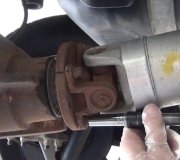Welcome to 2CarPros.
First, here is a link that discusses the most common causes of transmission issues. Take a look through it to see if anything mirrors what you are experiencing.
https://www.2carpros.com/articles/automatic-transmission-problems
Next, have you confirmed the transmission fluid is clean and full? Also, if the check engine light is staying on, I recommend having the computer scanned for diagnostic trouble codes. These codes can point you in the direction of the problem. Here is a quick video that shows how it is done.
https://youtu.be/YV3TRZwer8k
I realize most people don't own a scanner, but if the light is on, this should be done. Often times parts stores will do it for free, but not all of them have scanners able to read transmission codes.
Check the fluid level and if the light is on, have the computer scanned for codes. Let me know what you find so I can better direct you.
Here are the specific directions for your vehicle to check transmission fluid level. If it is low, you must use the recommended CVT transmission fluid listed in these directions. Don't use regular automatic transmission fluid. The attached picture correlates with these directions.
CVT FLUID
Adjustment
CVT fluid: Refer to "General Specification" See: Continuously Variable Transmission/Transaxle, CVT > Mechanical > General Specification.
Fluid capacity: Refer to "General Specification" See: Continuously Variable Transmission/Transaxle, CVT > Mechanical > General Specification.
CAUTION:
- Use only Genuine NISSAN CVT Fluid NS-3. Using transmission fluid other than Genuine NISSAN
CVT Fluid NS-3 will damage the CVT, which is not covered by the (NISSAN new vehicle limited) warranty.
- During adjustment of the CVT fluid level, check CONSULT so that the oil temperature may be maintained from 35 to 45 C (95 to 113 F).
- Use caution when looking into the drain hole as there is a risk of dripping fluid entering the eye.
1.Check that the selector lever is in the "P" position, then completely engage the parking brake.
2.Start the engine.
3.Adjust the CVT fluid temperature to be approximately 40 C (104 F).
NOTE:
The CVT fluid is largely affected by temperature. Therefore be sure to use CONSULT and check the
"FLUID TEMP" under "TRANSMISSION" in "Data Monitor" while adjusting.
4.While depressing the brake pedal, shift the selector lever to the entire position from "P" to "L", and shift it to the "P" position.
NOTE:
Hold the lever at each position for 5 seconds.
5.Lift up the vehicle.
6.Check that there is no CVT fluid leakage.
7.Remove the drain plug. Refer to "Exploded View" See: Fluid Pan, CVT > Removal and Replacement > Exploded View.
See Pic 1
8.Install the charging pipe set (KV311039S0) (A) into the drain plug hole.
CAUTION:
Tighten the charging pipe by hand.
9.Install the ATF changer hose (B) to the charging pipe.
CAUTION:
Press the ATF changer hose all the way onto the charging pipe until it stops.
10.Fill approximately 0.5 liter (1/2 US qt, 1/2 lmp qt) of the CVT
fluid.
11.Remove the ATF changer hose from the charging pipe, and check that the CVT fluid drains out from the charging pipe. If it does not drain out, perform charging again.
CAUTION:
Perform this work with the vehicle idling.
12.When the flow of CVT fluid slows to a drip, remove the charging pipe from the oil pan.
13.Tighten the drain plug to the specified torque. Refer to "Exploded View" See: Fluid Pan, CVT > Removal and Replacement > Exploded View.
CAUTION:
Never reuse drain plug gasket.
14.Lift down the vehicle.
15.Stop the engine.
Let me know what you find or if you have other questions.
Take care,
Joe
Image (Click to make bigger)
Saturday, March 23rd, 2019 AT 9:07 PM




